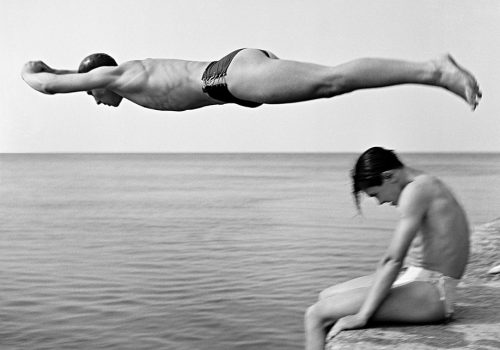This exhibition, a retrospective on view at the Maison Européenne de la Photographie in Paris, covers more than sixty years of the career of this interesting and innovative Italian photographer whose work, constantly changing, escapes all classification.
Nino Migliori surprises by the extent of his production and the diversity of the projects that he creates. All that Migliori made and continues to make, all that he produced and what he thought, revolves around a single strength: understanding what photography is and how this language, made of chemical balances and mechanical devices, has entered into our daily lives and irreparably changed it. This unique approach comes from realism, from this need to give a tangible and visible reality to daily life.
“I started with photography in 1948,” he says. “We were just out of the war, and I felt the need to seize life, reality, by capturing moments of every day life that now seem banal to us, but which at the time had a strong significance, no doubt linked to the feeling of freedom and the ability to choose.”
Migliori would go to people’s houses, capturing ceremonies, parties, even going to the hairdresser or the local bar just before closing time. His purely documentary style is close to that of the humanist photographers of the second half of the 20th century, but he also tried new points of view, transforming the view of the city with new perspectives and artistic poses. His photography is whole, brazen, and curious about everything. This reality approach is common to the photographers of his generation – Giacomelli, de Biasi, Roiter – even if the result is different.
The series Murs (Walls) marked the beginning of research into the photographic language and its possible interpretations that can still be pursued today: “I made Murs because I was interested in humanity. These are the only documents of its past from the Altamira Caves up to the graffiti and murals of Pompeii.”
The work on the walls illustrates this need to give testimony to the gestures, the traces of man and the passage of time. What interests Migliori is also his own action, that of the artist, deus ex machina, that chooses, stages, and takes the shot.
He continues: “Around that time in a little room at my place, I tinkered around, because of lack of means, with a camera obscura, and I developed and printed at night with the thirst to see the results appear. And it was then that I fell on this strange phenomenon. A tricking of developer poorly fixed on sensitive paper opened a whole new world to me, not only a ‘real’ representation, but the possibility to conceive an image with fantasy and movement. From that moment, a continual experimentation was born, whether it be with technical innovations like oxidation, pyrograms, and hydrograms, or with older techniques like cliché-verres or photograms.”
Migliori’s Polaroids represent a fundamental part of his work, especially from the 1980s. With the Polaroid, he explored leaving his own prints on the photographic paper during the short development time, this ephemeral moment in the banality of the snapshot. “With the Polaroids, I realized that making a little pressure with my nail or better yet with something rigid, the image would develop before my eyes and on the surface, little by little, marks of red, yellow, and black, would distort and reform according to the intensity of the pressure.”
That happens to be during the same period that Migliori began to create installations/performances like the legendary Controtempo Blu in 1977 at the Galleria Blu where each guest carried a Polaroid just taken by another guest around their necks, thus creating a circle of identity and portraits all linked to each other.
Migliori lives with the time, he listens, he watches, he equates and makes comparisons between the experiences that surround us. He is very attentive to new means of communication, curious about new photography potentials. Making photography, states Nino Migliori, means choosing and transforming. Almost like an alchemic procedure, the chosen material is transformed into something else, like a memory for those to come, or a question for the contemporaries, a new course to navigate, among all the pathways that Migliori has opened.
Alessandra Mauro
Alessandra Mauro is a journalist, art critic, and Italian exhibition curator. She lives and works in Rome.
Nino Migliori, La matière des rêves
From January 17 through February 25, 2018
Maison Européenne de la Photographie
5/7 Rue de Fourcy
75004 Paris
France
















